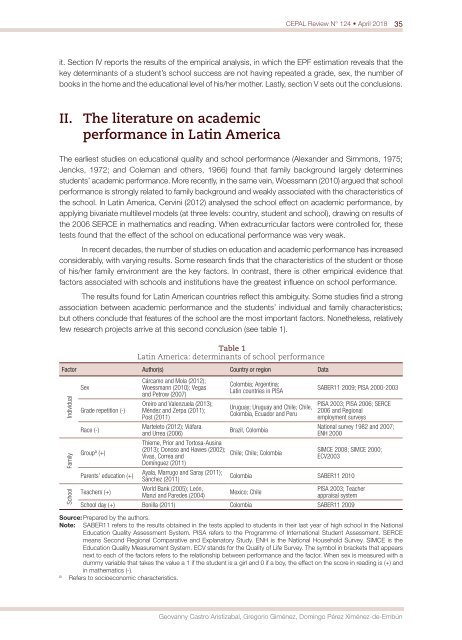CEPAL Review no. 124
April 2018
April 2018
Create successful ePaper yourself
Turn your PDF publications into a flip-book with our unique Google optimized e-Paper software.
<strong>CEPAL</strong> <strong>Review</strong> N° <strong>124</strong> • April 2018<br />
35<br />
it. Section IV reports the results of the empirical analysis, in which the EPF estimation reveals that the<br />
key determinants of a student’s school success are <strong>no</strong>t having repeated a grade, sex, the number of<br />
books in the home and the educational level of his/her mother. Lastly, section V sets out the conclusions.<br />
II. The literature on academic<br />
performance in Latin America<br />
The earliest studies on educational quality and school performance (Alexander and Simmons, 1975;<br />
Jencks, 1972; and Coleman and others, 1966) found that family background largely determines<br />
students’ academic performance. More recently, in the same vein, Woessmann (2010) argued that school<br />
performance is strongly related to family background and weakly associated with the characteristics of<br />
the school. In Latin America, Cervini (2012) analysed the school effect on academic performance, by<br />
applying bivariate multilevel models (at three levels: country, student and school), drawing on results of<br />
the 2006 SERCE in mathematics and reading. When extracurricular factors were controlled for, these<br />
tests found that the effect of the school on educational performance was very weak.<br />
In recent decades, the number of studies on education and academic performance has increased<br />
considerably, with varying results. Some research finds that the characteristics of the student or those<br />
of his/her family environment are the key factors. In contrast, there is other empirical evidence that<br />
factors associated with schools and institutions have the greatest influence on school performance.<br />
The results found for Latin American countries reflect this ambiguity. Some studies find a strong<br />
association between academic performance and the students’ individual and family characteristics;<br />
but others conclude that features of the school are the most important factors. Nonetheless, relatively<br />
few research projects arrive at this second conclusion (see table 1).<br />
Table 1<br />
Latin America: determinants of school performance<br />
Factor Author(s) Country or region Data<br />
Individual<br />
Family<br />
School<br />
Sex<br />
Grade repetition (-)<br />
Race (-)<br />
Group a (+)<br />
Parents’ education (+)<br />
Teachers (+)<br />
Cárcamo and Mola (2012);<br />
Woessmann (2010); Vegas<br />
and Petrow (2007)<br />
Oreiro and Valenzuela (2013);<br />
Méndez and Zerpa (2011);<br />
Post (2011)<br />
Marteleto (2012); Viáfara<br />
and Urrea (2006)<br />
Thieme, Prior and Tortosa-Ausina<br />
(2013); Do<strong>no</strong>so and Hawes (2002);<br />
Vivas, Correa and<br />
Domínguez (2011)<br />
Ayala, Marrugo and Saray (2011);<br />
Sánchez (2011)<br />
World Bank (2005); León,<br />
Manzi and Paredes (2004)<br />
Colombia; Argentina;<br />
Latin countries in PISA<br />
Uruguay; Uruguay and Chile; Chile,<br />
Colombia, Ecuador and Peru<br />
Brazil, Colombia<br />
Chile; Chile; Colombia<br />
SABER11 2009; PISA 2000-2003<br />
PISA 2003; PISA 2006; SERCE<br />
2006 and Regional<br />
employment surveys<br />
National survey 1982 and 2007;<br />
ENH 2000<br />
SIMCE 2008; SIMCE 2000;<br />
ECV2003<br />
Colombia SABER11 2010<br />
Mexico; Chile<br />
PISA 2003; Teacher<br />
appraisal system<br />
School day (+) Bonilla (2011) Colombia SABER11 2009<br />
Source: Prepared by the authors.<br />
Note: SABER11 refers to the results obtained in the tests applied to students in their last year of high school in the National<br />
Education Quality Assessment System. PISA refers to the Programme of International Student Assessment. SERCE<br />
means Second Regional Comparative and Explanatory Study. ENH is the National Household Survey. SIMCE is the<br />
Education Quality Measurement System. ECV stands for the Quality of Life Survey. The symbol in brackets that appears<br />
next to each of the factors refers to the relationship between performance and the factor. When sex is measured with a<br />
dummy variable that takes the value a 1 if the student is a girl and 0 if a boy, the effect on the score in reading is (+) and<br />
in mathematics (-).<br />
a<br />
Refers to socioeco<strong>no</strong>mic characteristics.<br />
Geovanny Castro Aristizabal, Gregorio Giménez, Domingo Pérez Ximénez-de-Embún


















